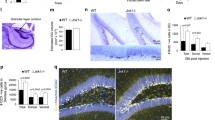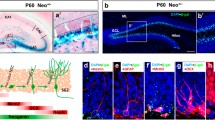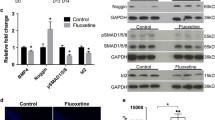Abstract
β-catenin (key mediator in the Wnt signaling pathway) contributes to the pathophysiology of mood disorders, associated to neurogenesis and neuroplasticity. Decreased β-catenin protein levels have been observed in the hippocampus and prefrontal cortex of depressed subjects. Additionally, the antidepressants exert, at least in part, their neurogenic effects by increasing β-catenin levels in the subgranular zone of the hippocampus. To further understand the role of β-catenin in depression and anxiety, we generated two conditional transgenic mice in which β-catenin was either inactivated or stabilized in cells expressing CreERT under the control of the astrocyte-specific glutamate transporter (GLAST) promoter inducible by tamoxifen, which presents high expression levels on the subgranular zone of the hippocampus. Here, we show that β-catenin inactivation in GLAST-expressing cells enhanced anxious/depressive-like responses. These behavioral changes were associated with impaired hippocampal proliferation and markers of immature neurons as doublecortin. On the other hand, β-catenin stabilization induced an anxiolytic-like effect in the novelty suppressed feeding test and tended to ameliorate depressive-related behaviors. In these mice, the control over the Wnt/β-catenin pathway seems to be tighter as evidenced by the lack of changes in some proliferation markers. Moreover, animals with stabilized β-catenin showed resilience to some anxious/depressive manifestations when subjected to the corticosterone model of depression. Our findings demonstrate that β-catenin present in GLAST-expressing cells plays a critical role in the development of anxious/depressive-like behaviors and resilience, which parallels its regulatory function on hippocampal proliferation. Further studies need to be done to clarify the importance of these changes in other brain areas also implicated in the neurobiology of anxiety and depressive disorders.








Similar content being viewed by others
References
Behrens J, von Kries JP, Kühl M, Bruhn L, Wedlich D, Grosschedl R, Birchmeier W (1996) Functional interaction of beta-catenin with the transcription factor LEF-1. Nature 382:638–642. https://doi.org/10.1038/382638a0
Kemler R (1993) From cadherins to catenins: cytoplasmic protein interactions and regulation of cell adhesion. Trends Genet 9:317–321. https://doi.org/10.1016/0168-9525(93)90250-L
Riese J, Yu X, Munnerlyn A, Eresh S, Hsu SC, Grosschedl R, Bienz M (1997) LEF-1, a nuclear factor coordinating signaling inputs from wingless and decapentaplegic. Cell 88:777–787. https://doi.org/10.1016/S0092-8674(00)81924-8
van de Wetering M, Cavallo R, Dooijes D, van Beest M, van Es J, Loureiro J, Ypma A, Hursh D et al (1997) Armadillo coactivates transcription driven by the product of the Drosophila segment polarity gene dTCF. Cell 88:789–799. https://doi.org/10.1016/S0092-8674(00)81925-X
Yu X, Malenka RC (2003) Beta-catenin is critical for dendritic morphogenesis. Nat Neurosci 6:1169–1177. https://doi.org/10.1038/nn1132
Karege F, Perroud N, Burkhardt S, Fernandez R, Ballmann E, La Harpe R, Malafosse A (2012) Protein levels of beta-catenin and activation state of glycogen synthase kinase-3beta in major depression. A study with postmortem prefrontal cortex. J Affect Disord 136:185–188. https://doi.org/10.1016/j.jad.2011.09.024
Pilar-Cuellar F, Vidal R, Diaz A, Castro E, dos Anjos S, Vargas V, Romero B, Valdizán EM (2014) Signaling pathways involved in antidepressant-induced cell proliferation and synaptic plasticity. Curr Pharm Des 20:3776–3794. https://doi.org/10.2174/13816128113196660736
Ren X, Rizavi HS, Khan MA, Dwivedi Y, Pandey GN (2013) Altered Wnt signalling in the teenage suicide brain: Focus on glycogen synthase kinase-3beta and beta-catenin. Int J Neuropsychopharmacol 16:945–955. https://doi.org/10.1017/S1461145712001010
Madsen TM, Newton SS, Eaton ME, Russell DS, Duman RS (2003) Chronic electroconvulsive seizure up-regulates beta-catenin expression in rat hippocampus: role in adult neurogenesis. Biol Psychiatry 54:1006–1014. https://doi.org/10.1016/S0006-3223(03)00700-5
Mostany R, Valdizan EM, Pazos A (2008) A role for nuclear beta-catenin in SNRI antidepressant-induced hippocampal cell proliferation. Neuropharmacology 55:18–26. https://doi.org/10.1016/j.neuropharm.2008.04.012
Pascual-Brazo J, Castro E, Diaz A, Valdizan EM, Pilar-Cuellar F, Vidal R, Treceño B, Pazos A (2012) Modulation of neuroplasticity pathways and antidepressant-like behavioural responses following the short-term (3 and 7 days) administration of the 5-HT(4) receptor agonist RS67333. Int J Neuropsychopharmacol 15:631–643. https://doi.org/10.1017/S1461145711000782
Pilar-Cuéllar F, Vidal R, Pazos A (2012) Subchronic treatment with fluoxetine and ketanserin increases hippocampal brain-derived neurotrophic factor, β-catenin and antidepressant-like effects. Br J Pharmacol 165:1046–1057. https://doi.org/10.1111/j.1476-5381.2011.01516.x
Wexler EM, Geschwind DH, Palmer TD (2008) Lithium regulates adult hippocampal progenitor development through canonical Wnt pathway activation. Mol Psychiatry 13:285–292. https://doi.org/10.1038/sj.mp.4002093
Duman RS, Nakagawa S, Malberg J (2001) Regulation of adult neurogenesis by antidepressant treatment. Neuropsychopharmacology 25:836–844. https://doi.org/10.1016/S0893-133X(01)00358-X
Revest JM, Dupret D, Koehl M, Funk-Reiter C, Grosjean N, Piazza PV, Abrous DN (2009) Adult hippocampal neurogenesis is involved in anxiety-related behaviors. Mol Psychiatry 14:959–967. https://doi.org/10.1038/mp.2009.15
Santarelli L, Saxe M, Gross C, Surget A, Battaglia F, Dulawa S, Weisstaub N, Lee J et al (2003) Requirement of hippocampal neurogenesis for the behavioral effects of antidepressants. Science 301:805–809. https://doi.org/10.1126/science.1083328
Snyder JS, Soumier A, Brewer M, Pickel J, Cameron HA (2011) Adult hippocampal neurogenesis buffers stress responses and depressive behaviour. Nature 476:458–461. https://doi.org/10.1038/nature10287
Bessa JM, Ferreira D, Melo I, Marques F, Cerqueira JJ, Palha JA, Almeida OF, Sousa N (2009) The mood-improving actions of antidepressants do not depend on neurogenesis but are associated with neuronal remodeling. Mol Psychiatry 14:764–773. https://doi.org/10.1038/mp.2008.119
David DJ, Samuels BA, Rainer Q, Wang JW, Marsteller D, Mendez I, Drew M, Craig DA et al (2009) Neurogenesis-dependent and -independent effects of fluoxetine in an animal model of anxiety/depression. Neuron 62:479–493. https://doi.org/10.1016/j.neuron.2009.04.017
Lagace DC, Benavides DR, Kansy JW, Mapelli M, Greengard P, Bibb JA, Eisch AJ (2008) Cdk5 is essential for adult hippocampal neurogenesis. Proc Natl Acad Sci U S A 105:18567–18571. https://doi.org/10.1073/pnas.0810137105
Chenn A, Walsh CA (2002) Regulation of cerebral cortical size by control of cell cycle exit in neural precursors. Science 297:365–369. https://doi.org/10.1126/science.1074192
Chenn A, Walsh CA (2003) Increased neuronal production, enlarged forebrains and cytoarchitectural distortions in beta-catenin overexpressing transgenic mice. Cereb Cortex 13:599–606. https://doi.org/10.1093/cercor/13.6.599
Varela-Nallar L, Inestrosa NC (2013) Wnt signaling in the regulation of adult hippocampal neurogenesis. Front Cell Neurosci 7:100. https://doi.org/10.3389/fncel.2013.00100
Mori T, Tanaka K, Buffo A, Wurst W, Kuhn R, Gotz M (2006) Inducible gene deletion in astroglia and radial glia—a valuable tool for functional and lineage analysis. Glia 54:21–34. https://doi.org/10.1002/glia.20350
Harada N, Tamai Y, Ishikawa T, Sauer B, Takaku K, Oshima M, Taketo MM (1999) Intestinal polyposis in mice with a dominant stable mutation of the beta-catenin gene. EMBO J 18:5931–5942. https://doi.org/10.1093/emboj/18.21.5931
Soriano P (1999) Generalized lacZ expression with the ROSA26 Cre reporter strain. Nat Genet 21:70–71. https://doi.org/10.1038/5007
Gourley SL, Taylor JR (2009) Recapitulation and reversal of a persistent depression-like syndrome in rodents. In: Current Protocols in Neuroscience 49:9.32.1–9.32.11. doi: https://doi.org/10.1002/0471142301.ns0932s49.
Linge R, Pazos Á, Díaz Á (2013) Social isolation differentially affects anxiety and depressive-like responses of bulbectomized mice. Behav Brain Res 245:1–6. https://doi.org/10.1016/j.bbr.2013.01.041
Kuhn HG, Winkler J, Kempermann G, Thal LJ, Gage FH (1997) Epidermal growth factor and fibroblast growth factor-2 have different effects on neural progenitors in the adult rat brain. J Neurosci 17:5820–5829 270–6474/97/175820–10$05.00/0.
Brault V, Moore R, Kutsch S, Ishibashi M, Rowitch DH, McMahon AP, Sommer L, Boussadia O et al (2001) Inactivation of the beta-catenin gene by Wnt1-Cre-mediated deletion results in dramatic brain malformation and failure of craniofacial development. Development 128:1253–1264
Ninkovic J, Mori T, Gotz M (2007) Distinct modes of neuron addition in adult mouse neurogenesis. J Neurosci 27:10906–10911. https://doi.org/10.1523/JNEUROSCI.2572-07.2007
Võikar V, Kõks S, Vasar E, Rauvala H (2001) Strain and gender differences in the behavior of mouse lines commonly used in transgenic studies. Physiol Behav 72:271–281. https://doi.org/10.1016/S0031-9384(00)00405-4.
Ming GL, Song H (2011) Adult neurogenesis in the mammalian brain: significant answers and significant questions. Neuron 70:687–702. https://doi.org/10.1016/j.neuron.2011.05.001
Mich JK, Signer RA, Nakada D, Pineda A, Burgess RJ, Vue TY, Johnson JE, Morrison SJ (2014) Prospective identification of functionally distinct stem cells and neurosphere-initiating cells in adult mouse forebrain. elife 3:e02669. https://doi.org/10.7554/eLife.02669.
Jungblut M, Tiveron MC, Barral S, Abrahamsen B, Knobel S, Pennartz S, Schmitz J, Perraut M et al (2012) Isolation and characterization of living primary astroglial cells using the new GLAST-specific monoclonal antibody ACSA-1. Glia 60:894–907. https://doi.org/10.1002/glia.22322
Lutgen V, Narasipura SD, Sharma A, Min S, Al-Harthi L (2016) β-catenin signaling positively regulates glutamate uptake and metabolism in astrocytes. J Neuroinflammation 13:242. https://doi.org/10.1186/s12974-016-0691-7
Bao J, Ma HY, Schuster A, Lin YM, Yan W (2013) Incomplete cre-mediated excision leads to phenotypic differences between Stra8-iCre; Mov10l1(lox/lox) and Stra8-iCre; Mov10l1(lox/Δ) mice. Genesis 51:481–490. https://doi.org/10.1002/dvg.22389
Liu R, Dang W, Jianting M, Su C, Wang H, Chen Y, Tan Q (2012) Citalopram alleviates chronic stress induced depression-like behaviors in rats by activating GSK3beta signaling in dorsal hippocampus. Brain Res 1467:10–17. https://doi.org/10.1016/j.brainres.2012.05.030
Ge JF, Xu YY, Qin G, Cheng JQ, Chen FH (2016) Resveratrol ameliorates the anxiety- and depression-like behavior of subclinical hypothyroidism rat: possible involvement of the HPT axis, HPA axis, and Wnt/β-catenin pathway. Front Endocrinol (Lausanne) 7:44. https://doi.org/10.3389/fendo.2016.00044
Dias C, Feng J, Sun H, Shao NY, Mazei-Robison MS, Damez-Werno D, Scobie K, Bagot R et al (2014) β-catenin mediates stress resilience through Dicer1/microRNA regulation. Nature 516:51–55. https://doi.org/10.1038/nature13976
Zhou WJ, Xu N, Kong L, Sun SC, Xu XF, Jia MZ, Wang Y, Chen ZY (2016) The antidepressant roles of Wnt2 and Wnt3 in stress-induced depression-like behaviors. Transl Psychiatry 6:e892. https://doi.org/10.1038/tp.2016.122
Mao Y, Ge X, Frank CL, Madison JM, Koehler AN, Doud MK, Tassa C, Berry EM et al (2009) Disrupted in schizophrenia 1 regulates neuronal progenitor proliferation via modulation of GSK3beta/beta-catenin signaling. Cell 136:1017–1031. https://doi.org/10.1016/j.cell.2008.12.044
Gould TD, O’Donnell KC, Picchini AM, Dow ER, Chen G, Manji HK (2008) Generation and behavioral characterization of beta-catenin forebrain-specific conditional knock-out mice. Behav Brain Res 189:117–125. https://doi.org/10.1016/j.bbr.2007.12.028
Wang JW, David DJ, Monckton JE, Battaglia F, Hen R (2008) Chronic fluoxetine stimulates maturation and synaptic plasticity of adult-born hippocampal granule cells. J Neurosci 28:1374–1384. https://doi.org/10.1523/JNEUROSCI.3632-07.2008
Bodnoff SR, Suranyi-Cadotte B, Quirion R, Meaney MJ (1989) A comparison of the effects of diazepam versus several typical and atypical anti-depressant drugs in an animal model of anxiety. Psychopharmacology 97:277–279. https://doi.org/10.1007/BF00442264
Dulawa SC, Hen R (2005) Recent advances in animal models of chronic antidepressant effects: the novelty-induced hypophagia test. Neurosci Biobehav Rev 29:771–783. https://doi.org/10.1016/j.neubiorev.2005.03.017
Gould TD, Einat H, O’Donnell KC, Picchini AM, Schloesser RJ, Manji HK (2007) Beta-catenin overexpression in the mouse brain phenocopies lithium-sensitive behaviors. Neuropsychopharmacology 32:2173–2183. https://doi.org/10.1038/sj.npp.1301338.
Kaidanovich-Beilin O, Milman A, Weizman A, Pick CG, Eldar-Finkelman H (2004) Rapid antidepressive-like activity of specific glycogen synthase kinase-3 inhibitor and its effect on beta-catenin in mouse hippocampus. Biol Psychiatry 55:781–784. https://doi.org/10.1016/j.biopsych.2004.01.008
Lehmann ML, Brachman RA, Martinowich K, Schloesser RJ, Herkenham M (2013) Glucocorticoids orchestrate divergent effects on mood through adult neurogenesis. J Neurosci 33:2961–2972. https://doi.org/10.1523/JNEUROSCI.3878-12.2013
Levone BR, Cryan JF, O’Leary F (2014) Role of adult hippocampal neurogenesis in stress resilience. Neurobiol Stress 1:147–155. https://doi.org/10.1016/j.ynstr.2014.11.003.
Hill AS, Sahay A, Hen R (2015) Increasing adult hippocampal neurogenesis is sufficient to reduce anxiety and depression-like behaviors. Neuropsychopharmacology 40:2368–2378. https://doi.org/10.1038/npp.2015.85
Ciani L, Marzo A, Boyle K, Stamatakou E, Lopes DM, Anane D, McLeod F, Rosso SB et al (2015) Wnt signalling tunes neurotransmitter release by directly targeting synaptotagmin-1. Nat Commun 6:8302. https://doi.org/10.1038/ncomms9302
Zechner D, Fujita Y, Hülsken J, Müller T, Walther I, Taketo MM, Crenshaw EB 3rd, Birchmeier W et al (2003) Beta-catenin signals regulate cell growth and the balance between progenitor cell expansion and differentiation in the nervous system. Dev Biol 258:406–418. https://doi.org/10.1016/S0012-1606(03)00123-4.
Gao X, Arlotta P, Macklis JD, Chen J (2007) Conditional knock-out of beta-catenin in postnatal-born dentate gyrus granule neurons results in dendritic malformation. J Neurosci 27:14317–14325. https://doi.org/10.1016/j.ynstr.2014.11.003.
Lie DC, Colamarino SA, Song HJ, Desire L, Mira H, Consiglio A, Lein ES, Jessberger S et al (2005) Wnt signalling regulates adult hippocampal neurogenesis. Nature 437:1370–1375. https://doi.org/10.1038/nature04108
Wexler EM, Paucer A, Kornblum HI, Palmer TD, Geschwind DH (2009) Endogenous Wnt signaling maintains neural progenitor cell potency. Stem Cells 27:1130–1141. https://doi.org/10.1002/stem.36
Imura T, Wang X, Noda T, Sofroniew MV, Fushiki S (2010) Adenomatous polyposis coli is essential for both neuronal differentiation and maintenance of adult neural stem cells in subventricular zone and hippocampus. Stem Cells 28:2053–2064. https://doi.org/10.1002/stem.524
Woodhead GJ, Mutch CA, Olson EC, Chenn A (2006) Cell-autonomous beta-catenin signaling regulates cortical precursor proliferation. J Neurosci 26:12620–12630. https://doi.org/10.1523/JNEUROSCI.3180-06.2006
Piccin D, Morshead CM (2011) Wnt signaling regulates symmetry of division of neural stem cells in the adult brain and in response to injury. Stem Cells 29:528–538. https://doi.org/10.1002/stem.589
Encinas JM, Michurina TV, Peunova N, Park JH, Tordo J, Peterson DA, Fishell G, Koulakov A et al (2011) Division-coupled astrocytic differentiation and age-related depletion of neural stem cells in the adult hippocampus. Cell Stem Cell 8:566–579. https://doi.org/10.1016/j.stem.2011.03.010
Kim K, Pang KM, Evans M, Hay ED (2000) Overexpression of beta-catenin induces apoptosis independent of its transactivation function with LEF-1 or the involvement of major G1 cell cycle regulators. Mol Biol Cell 11:3509–3523. https://doi.org/10.1091/mbc.11.10.3509
Hirsch C, Campano LM, Wohrle S, Hecht A (2007) Canonical Wnt signaling transiently stimulates proliferation and enhances neurogenesis in neonatal neural progenitor cultures. Exp Cell Res 313:572–587. https://doi.org/10.1016/j.yexcr.2006.11.002
Rosso SB, Inestrosa NC (2013) WNT signaling in neuronal maturation and synaptogenesis. Front Cell Neurosci 7:103. https://doi.org/10.3389/fncel.2013.00103
Uchida N, Honjo Y, Johnson KR, Wheelock MJ, Takeichi M (1996) The catenin/cadherin adhesion system is localized in synaptic junctions bordering transmitter release zones. J Cell Biol 135:767–779. https://doi.org/10.1083/jcb.135.3.767
Noles SR, Chenn A (2007) Cadherin inhibition of beta-catenin signaling regulates the proliferation and differentiation of neural precursor cells. Mol Cell Neurosci 35:549–558. https://doi.org/10.1016/j.mcn.2007.04.012
Acknowledgements
This research was supported by the Spanish Ministry of Economy and Competitiveness (SAF2011-25020 and SAF2015-67457-R), Instituto de Salud Carlos III (FIS Grant PI13-00038), co-funded by the European Regional Development Fund (“A way to build Europe”), and Centro de Investigación Biomédica en Red de Salud Mental (CIBERSAM). We thank the technical assistance of Beatriz Romero, Alicia Martín, Isabel Ruiz, Helena Blanco, Victor Campa, and Raquel Gutierrez-Lanza. The authors would like to thank Dr. Jesús Pascual-Brazo, Dr. Magdalena Götz, Dr. Marian Ros, and Dr. Anna Pujol for their scientific advice, and especially to our deceased colleague Professor Elsa Valdizán for her initial contribution to this work.
Author information
Authors and Affiliations
Corresponding author
Ethics declarations
Conflict of Interest
The authors declare that they have no conflict of interest.
Rights and permissions
About this article
Cite this article
Vidal, R., Garro-Martínez, E., Díaz, Á. et al. Targeting β-Catenin in GLAST-Expressing Cells: Impact on Anxiety and Depression-Related Behavior and Hippocampal Proliferation. Mol Neurobiol 56, 553–566 (2019). https://doi.org/10.1007/s12035-018-1100-2
Received:
Accepted:
Published:
Issue Date:
DOI: https://doi.org/10.1007/s12035-018-1100-2




